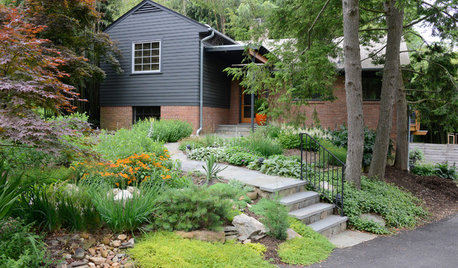DC Please Post Your Organic Lawn FAQs
claga
9 years ago
Related Stories

BEFORE AND AFTERSMore Room, Please: 5 Spectacularly Converted Garages
Design — and the desire for more space — turns humble garages into gracious living rooms
Full Story
RANCH HOMESHouzz Tour: An Eclectic Ranch Revival in Washington, D.C.
Well-considered renovations, clever art and treasures from family make their mark on an architect’s never-ending work in progress
Full Story
FRONT YARD IDEASBefore and After: Front Lawn to Prairie Garden
How they did it: Homeowners create a plan, stick to it and keep the neighbors (and wildlife) in mind
Full Story
BEFORE AND AFTERSSee 6 Yards Transformed by Losing Their Lawns
Wondering whether a turf lawn is the best use of your outdoor space? These homeowners did, and they found creative alternatives
Full Story
LANDSCAPE DESIGN15 Great Ideas for a Lawn-Free Yard
End the turf war for good with hardscaping, native grasses and ground covers that save water and are easier to maintain
Full Story
EARTH DAYThe Case for Losing the Traditional Lawn
Work less, help the environment and foster connections by just saying no to typical turf
Full Story
GREAT HOME PROJECTSHow to Replace Your Lawn With a Garden
New project for a new year: Lose the turfgrass for energy savings, wildlife friendliness and lower maintenance
Full Story
GROUND COVERSGive Your Lawn a Taste of the Wild
Consider the joys of an irregularly trimmed meadow lawn: It’s ecofriendly, visually interesting and still good for romping
Full Story
SAVING WATERHouzz Call: Are You Letting Go of Your Lawn?
Many facing a drought are swapping turf for less thirsty plantings. If you’re one of them, we’d like to hear about it
Full Story
MOST POPULARThe Polite House: On ‘No Shoes’ Rules and Breaking Up With Contractors
Emily Post’s great-great-granddaughter gives us advice on no-shoes policies and how to graciously decline a contractor’s bid
Full Story





gardengal48 (PNW Z8/9)
sc77 (6b MA)
Related Professionals
Southfield Landscape Architects & Landscape Designers · Lakeville Landscape Contractors · Palm Beach Gardens Landscape Contractors · Ringwood Landscape Contractors · South Lake Tahoe Landscape Contractors · Thonotosassa Landscape Contractors · Casselberry Landscape Contractors · Barrington Driveway Installation & Maintenance · Grand Rapids Driveway Installation & Maintenance · Indio Driveway Installation & Maintenance · Huntsville Swimming Pool Builders · Redlands Swimming Pool Builders · Greentree Fence Contractors · Kendall Fence Contractors · Modesto Fence ContractorsKimmsr
gardengal48 (PNW Z8/9)
Kimmsr
gardengal48 (PNW Z8/9)